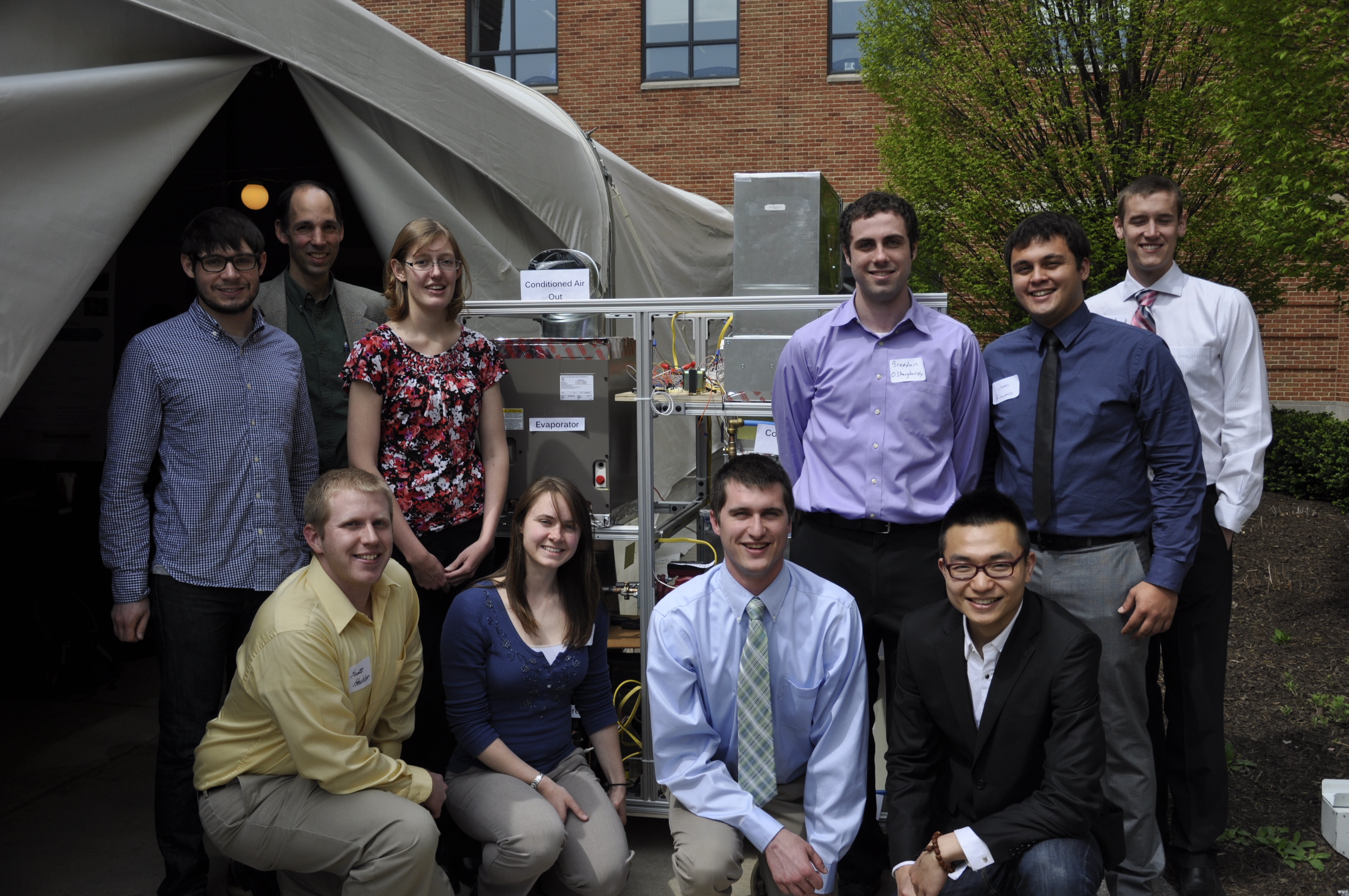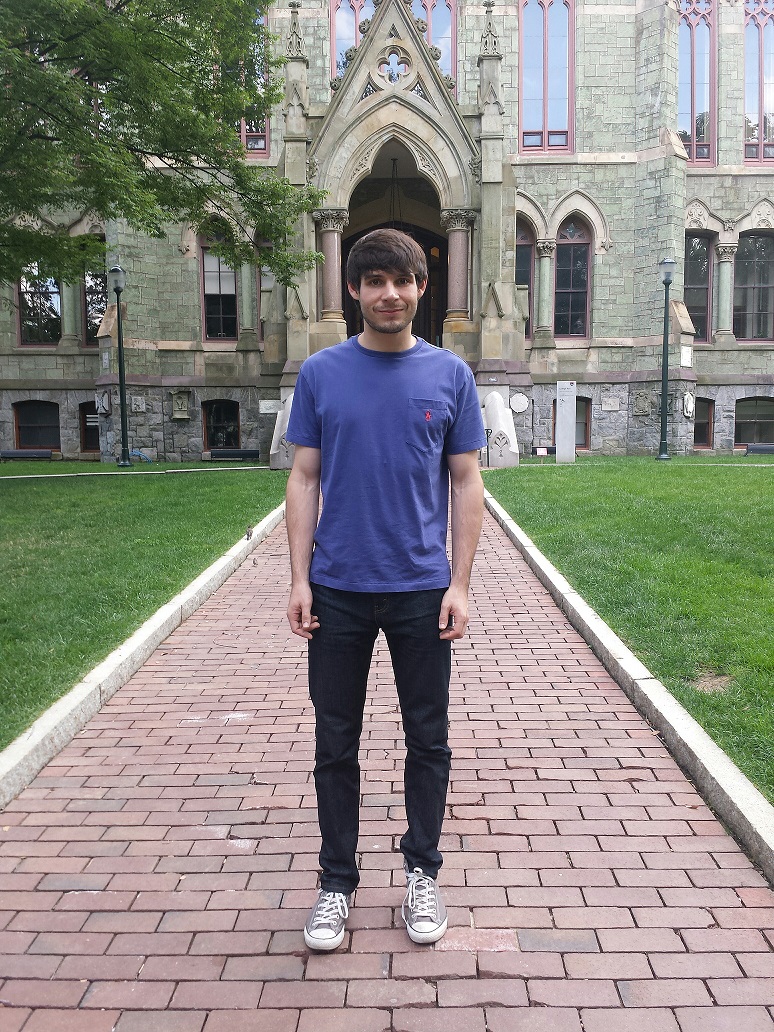Solar Decathlon Leads to Patent-Pending Technology, Design Career for OSU Alumnus
Wednesday, August 27, 2014By Carol Laurie
Matthew O’Kelly lives the benefits of his U.S. Department of Energy Solar Decathlon experience.
O’Kelly participated twice in the Solar Decathlon—first as the HVAC engineer for The Ohio State University (OSU) 2009 team and then as the project engineer for the OSU 2011 team. Since then, O’Kelly has not only established a successful design career but also been instrumental in developing a patent-pending technology that began with the OSU 2011 competition house.
After graduating from OSU with his master’s degree in 2012, O’Kelly secured a job with Priority Designs, an industrial design firm based in Columbus, Ohio. He says that his Solar Decathlon experience was a major reason he got the job.

The 2012 energyhawc capstone team included (back row, from left) Matthew O’Kelly, Dr. Mark Walter, Marcy Kaercher, Brendan O’Shaughnessy, James Rowland, and Chris Schleich, (front row, from left) Scott Heckler, Sarah Weals, Lee Trask, and Fandi Peng. Photo courtesy of Matthew O’Kelly.
“The 2011 competition was the defining experience of my academic career at OSU, and it was essential in helping me transition from a student to a professional engineer. The Solar Decathlon provided me with a great opportunity to work on an engineering project of significant scale with an amazing and diverse team,” O’Kelly says. “The competition had a condensed timeline, fundraising, blue-sky research and development, hardcore engineering, hands-on fabrication, marketing, and integration between design and engineering. Describing the amount of work, perseverance, and coordination that went into building and designing our house went a long way in convincing Priority Designs and others who interviewed me of my teamwork and engineering skills.”
Since the 2011 competition, O’Kelly has continued working with Dr. Mark Walter, OSU associate professor of Mechanical Engineering and the faculty lead for both the 2009 and 2011 OSU Solar Decathlon teams. Together, they developed the patent-pending “energyhawc” whole-house conditioning system and have run three capstone courses for OSU seniors in Mechanical Engineering. O’Kelly credits Walter and the Solar Decathlon experience as pivotal in “adding depth, social responsibility, and mentorship to my engineering education.”
O’Kelly explains that energyhawc (“hawc” stands for “hybrid air water conditioner”) integrates air conditioning, heating, water heating, ventilation, and de-humidification in one appliance and is up to 50% more energy-efficient than other whole-house conditioning systems. At 33 in. wide by 44 in. long by 60 in. tall (including the water tank), energyhawc is about the same size as a traditional central air-conditioning unit.
Walter and O’Kelly created energyhawc as a modularized, more efficient implementation of the separate sensible and latent cooling concepts they experimented with in their 2011 competition house.
“The ideas for energyhawc came directly from the HVAC system that we developed for our 2011 Solar Decathlon house,” explains Walter. “If we had not built the house, we would not have recognized the need for and then developed the energyhawc technology.”
Recently, O’Kelly and Walter won a $100,000 Ohio Third Frontier Startup Validation Fund grant to continue commercializing energyhawc. They have also brought on board James Rowland, a former capstone team member and current OSU master’s student. In June 2014, the OSU Technology and Commercialization Office submitted a utility patent application. O’Kelly, Walter, and Rowland are now working on a third prototype.

Solar Decathlon alumnus Matthew O’Kelly stands on the University of Pennsylvania campus in Philadelphia. O’Kelly is part of a team that has developed a patent-pending technology that began with the Solar Decathlon 2011 OSU house. Photo courtesy of Matthew O’Kelly.
“First and foremost, the Solar Decathlon is working to provide the novel solutions we will need to solve one of the greatest challenges of our generation: the energy crisis,” O’Kelly says. “The side effect of having students work on this problem is that we will have a new generation of engineering, architecture, and business people who are prepared to lead responsible and sustainable projects throughout the world.”
Although O’Kelly will continue to work with Walter and Rowland on energyhawc, he’s about to begin the next step in his professional career at the University of Pennsylvania, where he will be a doctoral student in electrical and systems engineering. He intends to shift his focus from product design back to research on embedded systems and controls, but he still plans to keep energy, infrastructure, and sustainability at the forefront of his career.
“The students, organizers, and supporters I worked with through the Solar Decathlon have sharpened my resolve to create more sustainable products, buildings, and infrastructure through both social and technological change,” he says. “I believe that I am not alone in these goals and that events like the Solar Decathlon are very important in training the next generation of engineers, designers, and entrepreneurs who will lead this charge.”
Carol Laurie is the communications manager of the U.S. Department of Energy Solar Decathlon.
Tags: Ohio State, Profiles, Solar Decathlon, Solar Decathlon 2009, Solar Decathlon 2011
